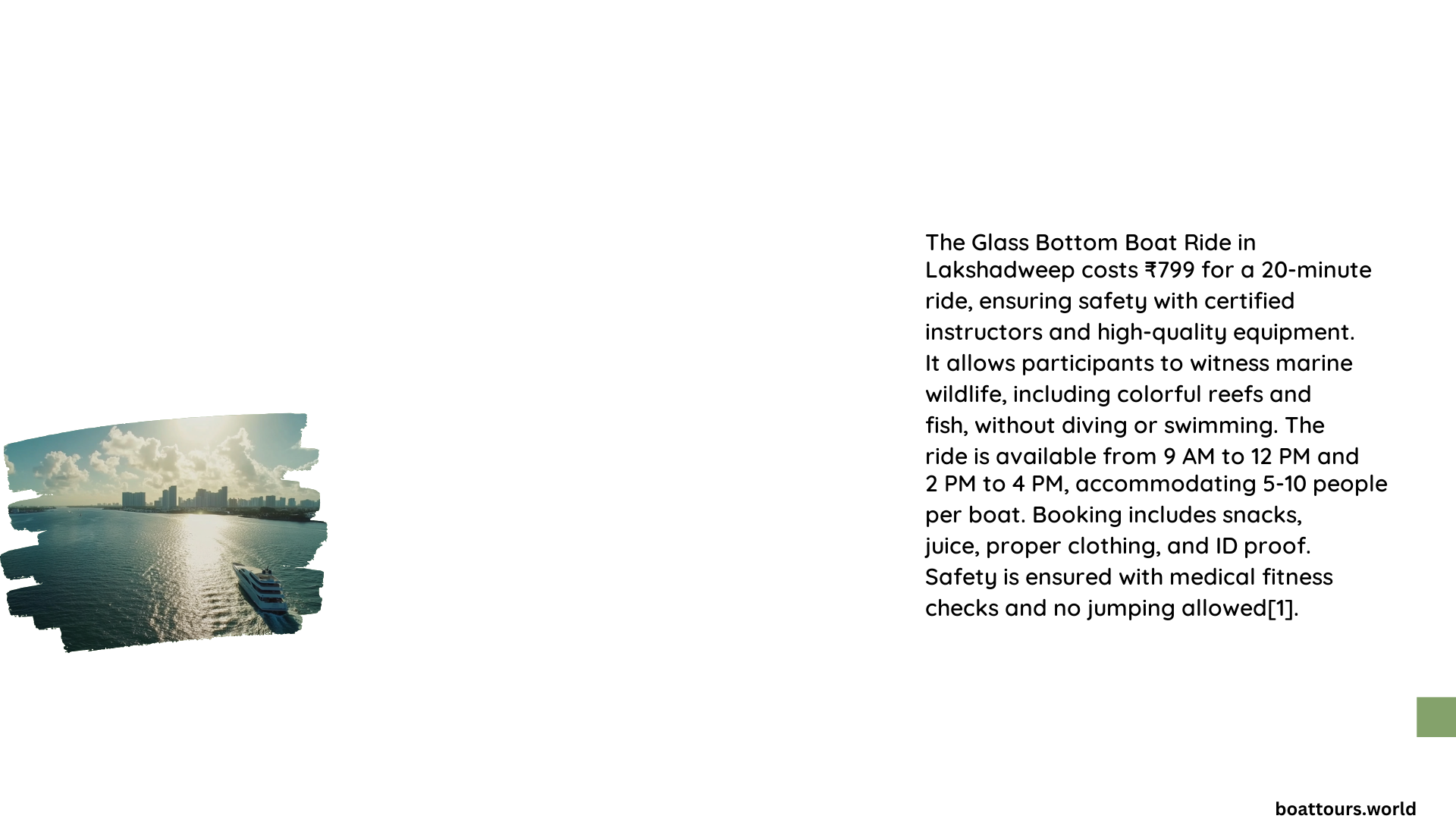The glass boat ride in Lakshadweep offers a unique and captivating experience for tourists. This 5-10 minute journey allows passengers to observe vibrant coral reefs, colorful fish, and diverse marine life through a transparent glass bottom. With a capacity of 5-10 people per ride, it provides a safe and comfortable way to explore the underwater world without getting wet. Available at a discounted rate of ₹799, this adventure is a must-try for visitors to Lakshadweep.
What Are the Key Features of the Glass Boat Ride in Lakshadweep?
The glass boat ride in Lakshadweep boasts several distinctive features that make it a popular attraction:
- Transparent Glass Bottom: The boat’s floor is made of clear glass, allowing passengers to view the underwater world directly beneath them.
- Seating Capacity: Each boat can accommodate between 5 to 10 people, ensuring an intimate experience.
- Safety Measures: Certified instructors and high-quality safety equipment are provided for all passengers.
- Duration: The ride typically lasts between 5 to 10 minutes, offering a quick yet immersive experience.
- Marine Life Viewing: Passengers can observe colorful coral reefs, tropical fish, and other aquatic creatures in their natural habitat.
How Much Does the Glass Boat Ride in Lakshadweep Cost?

The pricing for the glass boat ride in Lakshadweep is as follows:
- Regular Price: ₹999
- Discounted Price: ₹799 (current offer)
This affordable price point makes it accessible for most visitors to Lakshadweep. It’s important to note that while package deals are not specifically mentioned for the glass boat ride, it may be included in larger tour packages such as the Samudram package, which combines various water sports and island sightseeing activities.
When Are the Glass Boat Rides Available in Lakshadweep?
The glass boat rides in Lakshadweep operate during specific time slots:
- Morning Slot: 9 AM – 12 PM
- Afternoon Slot: 2 PM – 4 PM
These timings allow visitors to choose a convenient time that fits their schedule. While the exact frequency of rides within these slots is not specified, they are available throughout the day within the given time frames.
What Should Visitors Know Before Taking a Glass Boat Ride in Lakshadweep?
Before embarking on a glass boat ride in Lakshadweep, visitors should be aware of the following:
- Dress Code: Wear appropriate and snug clothing for comfort during the ride.
- Health Considerations: Inform the organizers of any health issues before participating.
- Age Restrictions: Children may require parental/guardian permission to participate.
- Booking: It’s advisable to book in advance, especially during peak seasons, to ensure availability.
- Physical Fitness: Ensure you are medically fit for the activity.
How Can Visitors Access the Glass Boat Ride in Lakshadweep?
Accessing the glass boat ride in Lakshadweep involves the following considerations:
- Transportation: For those on larger tour packages, bus transfers may be provided from boarding points to the boat launch area.
- Meeting Point: The ride typically begins from a designated spot on the island.
- Parking: Specific parking facilities for the glass boat ride are not mentioned, so it’s best to inquire with the tour operator.
- Accessibility: Follow the guidelines provided by the organizers to ensure a smooth experience.
What Makes the Glass Boat Ride in Lakshadweep Unique?
The glass boat ride in Lakshadweep stands out for several reasons:
- Pristine Waters: Lakshadweep’s clear waters offer excellent visibility of the underwater world.
- Rich Marine Biodiversity: The area is known for its diverse coral reefs and colorful fish species.
- Non-Invasive Observation: Allows visitors to view marine life without disturbing the ecosystem.
- Family-Friendly: Suitable for all ages, providing a safe way to experience underwater sights.
- Educational Experience: Offers insights into the local marine ecosystem.
How Does the Glass Boat Ride Contribute to Lakshadweep’s Tourism?
The glass boat ride plays a significant role in Lakshadweep’s tourism industry:
- Eco-Friendly Tourism: Promotes sustainable tourism by allowing observation without direct interaction with marine life.
- Unique Attraction: Offers a distinctive experience that sets Lakshadweep apart from other beach destinations.
- Economic Impact: Contributes to the local economy by attracting tourists and creating employment opportunities.
- Environmental Awareness: Raises awareness about marine conservation and the importance of coral reefs.
- Complementary Activity: Enhances the overall tourist experience when combined with other water sports and island activities.
What Are the Best Times of Year for a Glass Boat Ride in Lakshadweep?
While the glass boat ride is available year-round, certain seasons may offer better experiences:
- October to May: Generally considered the best time to visit Lakshadweep, with clear skies and calm seas.
- December to February: Peak tourist season with ideal weather conditions.
- Monsoon Season (June to September): May have limited availability due to rough seas and reduced visibility.
| Season | Months | Conditions |
|---|---|---|
| Peak Season | December – February | Ideal weather, clear waters |
| Shoulder Season | October – November, March – May | Good conditions, fewer crowds |
| Monsoon Season | June – September | Possible limitations due to weather |
How Can Visitors Enhance Their Glass Boat Ride Experience in Lakshadweep?
To make the most of the glass boat ride experience in Lakshadweep, consider these tips:
- Bring a Camera: Capture the underwater sights through the glass bottom (if permitted).
- Listen to the Guide: Pay attention to the instructor’s information about local marine life.
- Choose the Right Time: Opt for morning rides for clearer water visibility.
- Combine with Other Activities: Plan the ride as part of a broader itinerary of water sports and island exploration.
- Respect the Environment: Follow all guidelines to minimize impact on the marine ecosystem.
By following these suggestions, visitors can ensure a memorable and responsible glass boat ride experience in the beautiful waters of Lakshadweep.
